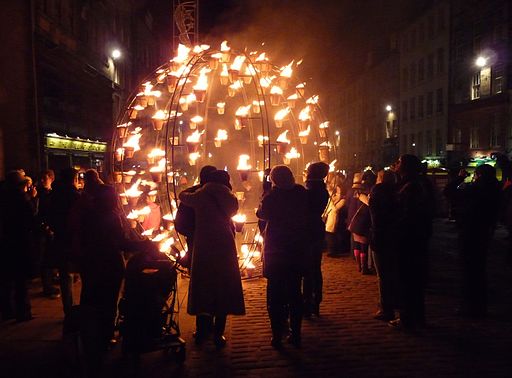This post is part of a series that might be characterized as Darwin’s Christmas. I will be taking a number of our current traditions and tracing their evolution.
Currently, most people around the world begin New Year’s celebrations on December 31, the last day of the Gregorian calendar. But as with so much in the modern world, it wasn’t always so. Although people have celebrated the beginning of a new year for millennia, astrological or agricultural events typically marked the new year.
The earliest recorded celebration of the beginning of a new year was in ancient Babylon, some 4,000 years ago. For Babylonians, the new year began with the first full moon following the vernal equinox, a date falling in late March. It was a massive religious festival that required a different ritual every day for 11 days.

(Dragon in Chinatown NYC Lunar New Year) [CC BY 2.0 (http://creativecommons.org/licenses/by/2.0)], via Wikimedia Commons
For early Romans, each new year began with the vernal equinox. A year had 304 days divided into 10 months. Over time, the calendar year deviated significantly from the sun year. In 46 B.C. Julius Caesar consulted astronomers and mathematicians to solve the problem. He added 90 days to that year, adjusted the length of months, and declared January 1 as the first day of the year. January honors the Roman god of beginnings—Janus—who has two faces that look forward and back. In 1582, Pope Gregory XIII established January 1 as new year’s day for Christians.
Vatican museum, Vatican City
Making a lot of noise—shooting guns, banging pots and pans, blaring car horns, playing loud music, setting off firecrackers—is supposed to scare away bad luck and evil spirits. Partying with family and/or friends is common, as is fireworks displays or other ritual midnight activities.
In the U.S., the dropping of the giant ball in Times Square, begun in 1907, is now watched by millions. Spin-offs involve publicly dropping items that represent an area’s culture, geography, or history: the Peach Drop in Atlanta, GA; Pickle Drops in Dillsburg, PA, and Mount Olive, NC; the Possum Drop in Tallapoosa, GA; Wylie the Walleye Fish Drop in Port Clinton, OH; the Bologna Drop in Lebanon, PA; a Watermelon Drop in Vincennes, IN; the Midnight Muskrat Dive in Princess Anne, MD; a Big Cheese Drop in Plymouth, WI; a Pine Cone Drop in Flagstaff, AZ; a Grape Drop in Temecula Valley, CA; a Donut Drop in Hagerstown, MD; a Flip-flop Drop in Folly Beach, SC; a Wrench Drop in Mechanicsburg, PA; Beach Ball Drop in Panama City Beach, FL; the Music Note Drop in Nashville, TN; Chile Drop in Las Cruces, Mexico. Surely I’ve missed some! Please feel free to comment on your favorites.

(https://www.dvidshub.net/image/511672) [Public domain], via Wikimedia Commons
In the Philippines, many wear new, bright, colorful clothes with circular patterns. In Brazil, wearing white on the beach to ring in the new year is supposed to bring good luck. In Italy, wearing red underwear on New Year’s Eve is traditional. Spanish tradition holds that wearing new red underwear brings good luck. In Venezuela, the underwear is yellow.
In Scotland, Hogmanay is celebrated with First-Footing (going to each other’s houses with gifts of whiskey and sometimes a lump of coal); Edinburgh hosts a 4 or 5 day festival, beginning on December 28th, including cannon fire and fireworks displays.

[CC BY 2.0 (http://creativecommons.org/licenses/by/2.0)], via Wikimedia Commons
North and South Korea celebrate New Years twice, a Lunar New Year which varies, and a Solar New Year which is always January 1.
The practice of making resolutions for the new year is thought to have been popular first among the ancient Babylonians.
And thus we come full circle—a fine New Year’s tradition!
